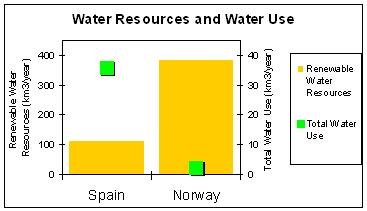|
|
 |
|
|
|
 |
| |
|
|
 |
Food & Climate
Read more |
Why is drought an important issue in Mediterranean countries?
Variable rainfall
The Mediterranean climates, with hot and dry summers, and cold and wet winters, are among the most variable of the world. Recurrent drought problems often affect entire countries over multi-year periods and often result in serious social problems.
|
|
|
|
|
 |
|
In general, precipitation is concentrated between October and March (southern regions like Algeria or Morocco) or April (northern regions like Portugal or Italy). Average temperature in this area decreases with increasing altitude and latitude. The weather is characterized by large inter-annual variability. Summer precipitation (June, July and August) is well below 100 mm in all regions, except in the Northwest areas (North of Spain and Portugal). In general, the dry period also shows the largest interannual variability.
|
 |
 |
|
1. Diagrams of climate for Lérida and Almería
From: CEDEX
|
|
 |
Each season water supply must be matched with water demands. During drought periods the shortfall in water availability leads to conflicts among water users and trans-boundary water disputes.
These figures show the distribution of precipitations, temperature and solar radiation for two different regions in Spain.
Lerida is a region in the Northeast of the country and is characterized by high differences of temperature between summer and winter and a quite even distribution of precipitation that increases in spring and autumn and is minimum during the summer months.
Almeria is a region also in Spain but around 500 km south from Lerida. There are great differences in the amount and the distribution of precipitation as seen in the graph, but also in the temperature, which is more similar all along the year for this location. Precipitation here is very low, but especially during the summer months, when it is close to none. |
Agriculture
Agriculture in the Mediterranean is both the main use of the land in terms of area (over fifty percent of total land area) and the principal water-consuming sector (over 80 percent of the total water demand in southern Mediterranean African countries and over sixty percent in the northern Mediterranean European countries. The adverse effects of drought are perceived to be associated with agricultural activities.
|
Drought affects food production and food security. Mediterranean cultures have been farming over several millennia and farmers are well aware of the negative impacts of drought. Irrigated agriculture in the region has greatly expanded to ensure food production targets increasing the problems during drought periods. The connections between water and food production in the region are receiving increasing attention as the concerns of food experts begin to encompass the realities of current and future water availability.
These figures show the different distribution of the use of water for two European countries, one in the North of Europe and the other one in the Mediterranean basin.
As it has just been said in the text, countries like Spain use most of the water for agricultural purposes while in Norway, Industry is the principal sector for water investment. It is also important to notice that the total amount of water used in Spain is around 18 times more than that used in Norway.
|
 |
 |
 |
|
2. Water use in the different sectors in Spain and Norway
Adapted from AQUASTAT, FAO
|
|
 |
 |
|
3. Water use in Norway and Spain
Adapted from AQUASTAT, FAO
|
|
 |
In this second figure of comparison it is clear that Spain can only have access to one fourth of the total available water in Norway, but, on the other hand the use of water is much higher in Spain than in Norway, being this a situation that worsens the problems with water availability and use.
|
|
Social and policy issues
In the Mediterranean, climate is an essential component of the natural capital and an important element of sustainable development. Water is not only a major socio-economic element but an essential cultural element as well. As a result, the policy debates related to water have been and will continue to be vigorous.
Effective measures to cope with scarcity are known, but are difficult to implement due to the variety of stakeholders and inadequate means to negotiate new policies. Any efforts made to improve communication among the scientific and decision-making communities will have great benefits for the future of water management in the region.
The social impacts of water scarcity in the Mediterranean (due to the great variety of users and interests put in water) are increasing and will likely be exacerbated as we have already mentioned. Cultural impediments to limiting the use of water are an additional source of concern.
|
Author: Marta Moneo and Ana Iglesias- Universidad Politécnica de Madrid - España
1. Scientific reviewer: Alex de Sherbinin - CIESIN, Columbia University - USA
2. Scientific reviewer: Lily Parshall - Goddard Institute for space studies, Columbia University - USA
Educational reviewer: Emilio Sternfeld - Colegio Virgen de Mirasierra - España
Last update: 12/05/2004 |
|
 |
|









